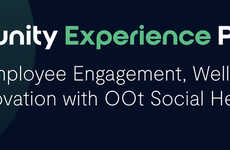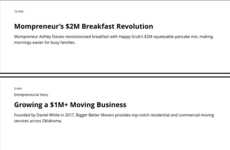
Accessible Canadian Communication
Tiana Reid — April 27, 2012 — Social Good
References: talk2one.net
SocialBusiness.org first became aware of David Robertson's social business Talk2One at the 2011 Social Finance Forum.
We got to dig a little bit deeper into how Talk2One developed, which, like many social enterprises, sprouted out of the desire to work toward fulfilling a need.
Four Questions with David Robertson
1. How did the idea for the business model come about?
Talk2One was first developed in South Africa as a telephony-based, training program used to inform and support large workforces in multiple languages about HIV/AIDS and other STDs. Access to information and the ability to communicate should be considered as basic human rights and upon returning to Canada, it became clear that there was a need and opportunity to “bridge the digital divide” for many thousands of marginalized and at-risk Canadians with no reliable phone who are isolated from the community and are often unable to access social-based information that can help them make informed decisions that affect their lives.
2. How did you decide to join this sector?
With many years' experience in marketing and telecommunications, along with a strong personal commitment to effective social change solutions, the need for this kind of social support service became self-evident and manifested itself into providing a free “public service” using existing technology accessible by everyone, regardless of their social status or ability to pay. From the onset Talk2One Ltd. was established as a for-profit company with a social purpose and has since been certified as a “B” or Beneficial Corporation providing services to thousands of people on social assistance for the past three years now with a proven track record.
3. How do you get your inspiration?
Inspiration comes from having experienced homelessness and poverty first hand and wanting to help our members escape the spiral of poverty using my skills and background to create positive change. Monitoring the needs of the members and support agencies by way of regular interviews and system surveys allows us to determine their requirements and rise to the challenge of providing low cost but effective solutions in a timely manner. Our inspiration comes from hearing from our members who are now able to receive messages from potential employers, landlords or their family and friends and are no longer isolated form society.
4. How do you reset yourself to be creative? Do you have any rituals?
There are usually two steps to the creative process as good solutions are not necessarily the first idea in one’s head. First is to establish the need or problem based on field input, conversations with colleagues, market research over the internet or at the library and isolating the key issues to be resolved. Step two requires a quite space and computer time and involves first sketching out the solution in broad strokes and then refining each phase in writing so that others may share their thoughts as a critique. Creative ideas are no good unless they take a permanent form.
We got to dig a little bit deeper into how Talk2One developed, which, like many social enterprises, sprouted out of the desire to work toward fulfilling a need.
Four Questions with David Robertson
1. How did the idea for the business model come about?
Talk2One was first developed in South Africa as a telephony-based, training program used to inform and support large workforces in multiple languages about HIV/AIDS and other STDs. Access to information and the ability to communicate should be considered as basic human rights and upon returning to Canada, it became clear that there was a need and opportunity to “bridge the digital divide” for many thousands of marginalized and at-risk Canadians with no reliable phone who are isolated from the community and are often unable to access social-based information that can help them make informed decisions that affect their lives.
2. How did you decide to join this sector?
With many years' experience in marketing and telecommunications, along with a strong personal commitment to effective social change solutions, the need for this kind of social support service became self-evident and manifested itself into providing a free “public service” using existing technology accessible by everyone, regardless of their social status or ability to pay. From the onset Talk2One Ltd. was established as a for-profit company with a social purpose and has since been certified as a “B” or Beneficial Corporation providing services to thousands of people on social assistance for the past three years now with a proven track record.
3. How do you get your inspiration?
Inspiration comes from having experienced homelessness and poverty first hand and wanting to help our members escape the spiral of poverty using my skills and background to create positive change. Monitoring the needs of the members and support agencies by way of regular interviews and system surveys allows us to determine their requirements and rise to the challenge of providing low cost but effective solutions in a timely manner. Our inspiration comes from hearing from our members who are now able to receive messages from potential employers, landlords or their family and friends and are no longer isolated form society.
4. How do you reset yourself to be creative? Do you have any rituals?
There are usually two steps to the creative process as good solutions are not necessarily the first idea in one’s head. First is to establish the need or problem based on field input, conversations with colleagues, market research over the internet or at the library and isolating the key issues to be resolved. Step two requires a quite space and computer time and involves first sketching out the solution in broad strokes and then refining each phase in writing so that others may share their thoughts as a critique. Creative ideas are no good unless they take a permanent form.
Trend Themes
1. Accessible Communication Services - The trend of providing accessible communication services to marginalized and at-risk populations in order to bridge the digital divide and facilitate social connection, informed decision-making, and positive social change.
2. Social Support Technologies - The trend of utilizing technology to provide social support services to individuals in need, regardless of their social status or ability to pay, with a focus on addressing specific challenges such as homelessness, poverty, and isolation.
3. Humanitarian Telephony Solutions - The trend of developing telephony-based solutions that address global humanitarian challenges, such as HIV/AIDS and other STDs, by leveraging the power of information and communication to educate and support large populations.
Industry Implications
1. Telecommunications - The telecommunications industry has an opportunity to innovate and offer accessible communication services to marginalized communities, using existing technology and infrastructure to bridge the digital divide.
2. Social Services - The social services industry can leverage social support technologies to provide more efficient and effective assistance to individuals in need, improving outcomes and enabling positive social change.
3. Public Health - The public health sector can explore the potential of humanitarian telephony solutions to disseminate important health information, education, and support services to large populations, particularly in areas with limited access to healthcare resources.
0.7
Score
Popularity
Activity
Freshness























